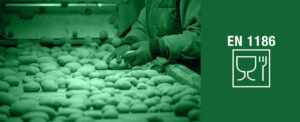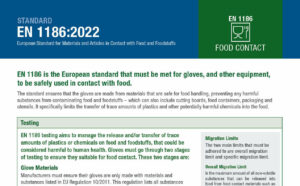STANDARD
EN 1186:2022
European Standard for Materials and Articles in Contact with Food and Foodstuffs

EN 1186 is the European standard that must be met for gloves, and other equipment, to be safely used in contact with food.
The standard ensures that the gloves are made from materials that are safe for food handling, preventing any harmful substances from contaminating food and foodstuffs – which can also include cutting boards, food containers, packaging and utensils. It specifically limits the transfer of trace amounts of plastics and other potentially harmful chemicals into the food.
Testing
EN 1186 testing aims to manage the release and/or transfer of trace amounts of plastics or chemicals on food and foodstuffs, that could be considered harmful to human health. Gloves must go through two stages of testing to ensure they suitable for food contact. These two stages are:
Glove Materials
Manufacturers must ensure their gloves are only made with materials and substances listed in EU Regulation 10/2011. This regulation lists all substances (including plastics) which are safe to be in contact with food and/or foodstuffs where human consumption is concerned. Manufacturers cannot include any materials in their gloves not on this list.
Migration Testing
Manufacturers must ensure they meet the overall and specific migration limits in
EN 1186-2:2022 and EN 1186-3:2022, which supersede EN 1186:2002.
The standard includes what chemicals can be used to replicate various food types in addition to the methods to be used:
- Aqueous: where plain water is used as the food simulant.
- Alcoholic: where 10% ethanol solution is used as the food simulant.
- Acidic: where 3% acetic acid solution is used as the food simulant.
- Fatty: where various equivalents are used as the food stimulant.
Typically these are iso-octane, 95% ethanol or olive oil.
Migration Limits
The two main limits that must be adhered to are overall migration limit and specific migration limit.
Overall Migration Limit
Is the maximum amount of all non-volatile substances that can be released into food from food contact materials such as gloves, packaging and utensils.
Specific Migration Limit
Is the maximum amount of a substance or group of substances, such as metals, that can be released into food. Acceptable migration levels are minuscule and vary by substance. No glove is allowed to transfer over 10mg of material per square decimetre of the tested area.
For the latest safety standards, classifications, testing criteria and ratings information, please refer to the appropriate governing body or association. Information contained in this document is subject to change without notice. As BDG® cannot control or anticipate the conditions under which a product may be used, each user should review the information in specific context of the planned use. To the maximum extent permitted by law, Bob Dale Gloves and Imports Ltd., and/or its affiliates, employees or representatives will not be responsible for damages of any nature resulting from the use or reliance upon the information contained in this sheet. No express or implied warranties are given other than those implied mandatory by law. BDG® products are not cut and puncture proof. Do not use with moving blades, tools or serrated blades.
